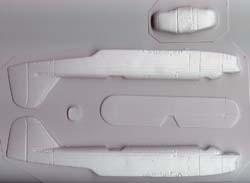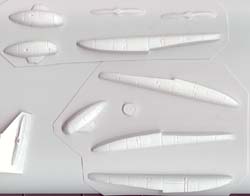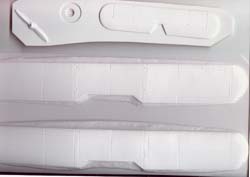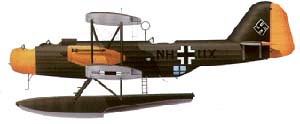Airmodel 1/72 Heinkel He59 | | Background The year was 1969 when a fellow named Franz Schaedler established one of the first small cottage industry model manufacturers that would produce vacuformed model kits. He issued numerous kits under his logo which gained fame and notoriety among modelers around the world. In 1980 however, Mr. Schaedler passed the torch of his cottage industry over to Richard Frank, owner of Frank-Modellbau who would then produce his own kits under this famed logo, and add to it a legacy of excellent model kits for advanced builders. This reputed logo was Airmodel.  Time ultimately took its toll on Mr. Frank. He eventually settled into "semi-retirement", producing kits sporadically, gradually building up a great backorder of kits that needed to be produced. In the end, Mr. Frank decided again to pass on the torch that was handed to him back in 1980 by Mr. Schaedler, to Matthias Simon. Mr. Simon is proud to carry forth Airmodel into the 21st century of model building, supplying beautifully crafted aircraft models to the masses of advanced model builders. Time ultimately took its toll on Mr. Frank. He eventually settled into "semi-retirement", producing kits sporadically, gradually building up a great backorder of kits that needed to be produced. In the end, Mr. Frank decided again to pass on the torch that was handed to him back in 1980 by Mr. Schaedler, to Matthias Simon. Mr. Simon is proud to carry forth Airmodel into the 21st century of model building, supplying beautifully crafted aircraft models to the masses of advanced model builders.
Mr. Simon does plan to issue NEW kits, and accessories to the modeling community in due time. However, at this time his priority is to reintroduce to the world the beautiful kits Airmodel has already become so well known for. The Aircraft
In 1976, a mold was devised by Airmodel, to produce a model of an aircraft seldom heard of by any but the most knowledged in Aviation lore. This aircraft was the Heinkel He 59, a twin engine biplane designed in 1930 for attack and reconnaissance purposes, in both wheeled and twin float equipped versions. The float equipped aircraft was settled on for series production in late 1933, for service as an Air Sea Rescue aircraft.  Its first use during war time would come during the Spanish Civil War, when a handful of them were used as night bombers and as anti-shipping patrol aircraft, the latter being specially outfitted with a 20 mm cannon to destroy sea vessels. Later, during the Battle of Britain these aircraft saw service as Air Sea Rescue aircraft, and were responsible for saving the life of many an aviator. Its first use during war time would come during the Spanish Civil War, when a handful of them were used as night bombers and as anti-shipping patrol aircraft, the latter being specially outfitted with a 20 mm cannon to destroy sea vessels. Later, during the Battle of Britain these aircraft saw service as Air Sea Rescue aircraft, and were responsible for saving the life of many an aviator.
By 1940, these obsolete aircraft were being progressively phased out of front line service in favor of the newer designed aircraft, that were better suited to the rigors of modern combat. This left the He 59 to fall into a variety of training roles and some reconnaissance duties where it labored forth into the war. The Kit  This kit comes with parts for two versions; a navigational trainer, and for the standard ASW/patrol/recon aircraft, differing only in a pair of conversion nose pieces. The kit contains 24 vacuformed parts on thick sheets of white styrene, that feature engraved panel lines, and strut placement indentations. One of the shortcomings of the molds, are that the panel lines remind one of Matchbox's trench work engraved panel lines - these look a bit wide and deep. Furthermore, the main components all have small bumps over them - molding points, minor defects that create these bumps. The one saving grace of this shortcoming is that they are easily sanded from the surface of the kit parts. This kit comes with parts for two versions; a navigational trainer, and for the standard ASW/patrol/recon aircraft, differing only in a pair of conversion nose pieces. The kit contains 24 vacuformed parts on thick sheets of white styrene, that feature engraved panel lines, and strut placement indentations. One of the shortcomings of the molds, are that the panel lines remind one of Matchbox's trench work engraved panel lines - these look a bit wide and deep. Furthermore, the main components all have small bumps over them - molding points, minor defects that create these bumps. The one saving grace of this shortcoming is that they are easily sanded from the surface of the kit parts.
You will also note that there is a complete lack of struts or detail parts, all of these must be provided by the builder! Thus what this translates to is, non-vac builders and inexperienced modelers who only deal in shake and bake models need not apply. This kit will not just fall together straight out of the box. It will take a great deal of work.  Included in the instructions are complete assembly plans, with views of interior sections and cutaways that display areas of the interior that would be visible from the exterior of the model. Also included are templates for struts, and their arrangement, as well as a sheet of color profiles by Rainer Gliss, reprinted in the instruction sheet with the generous permission of "Aviation New". Included in the instructions are complete assembly plans, with views of interior sections and cutaways that display areas of the interior that would be visible from the exterior of the model. Also included are templates for struts, and their arrangement, as well as a sheet of color profiles by Rainer Gliss, reprinted in the instruction sheet with the generous permission of "Aviation New".
There are several things that could improve the kit such as clear vac windscreens, plus perhaps and a fret of resin or injection molded parts for the struts and other details. This could save the modeler a great deal of time and heartache if this were done! Among these additions, improvement would be greatly made if white metal propellers and guns were added. (The guns you can get from Aviation Usk or Hannants, in the form of Aeroclub MG-15s.) Conclusion In summary, although an old kit, and lacking in modern luxuries, If you are interested in adding an interesting Luftwaffe specimen to your' collection that not just every modeler has six of, or would just like to challenge your' modeling skills - then I highly recommend that you check out this kit. Its a beautiful kit, that when built up is bound to be one of the most interesting conversation pieces in your' collection, and in the process will sparate the men from the boys of the modeling world. Acknowledgements
Review kit provided graciously by Matthias Simon of Airmodel. He specifically requested that the review be honest, and not pull any punches. He would like for people to hear about Airmodel yes, but he does not wish for them to be misled. Data on the history of Airmodel provided by "In Plastic WW2 Aircraft Kits" by John W. Burns. | 

 




|
